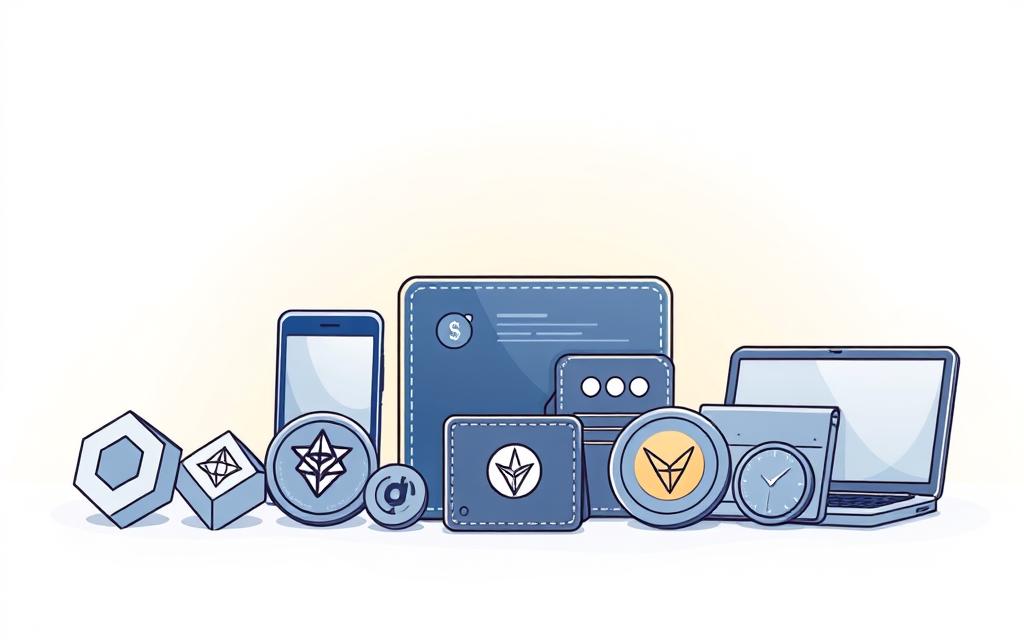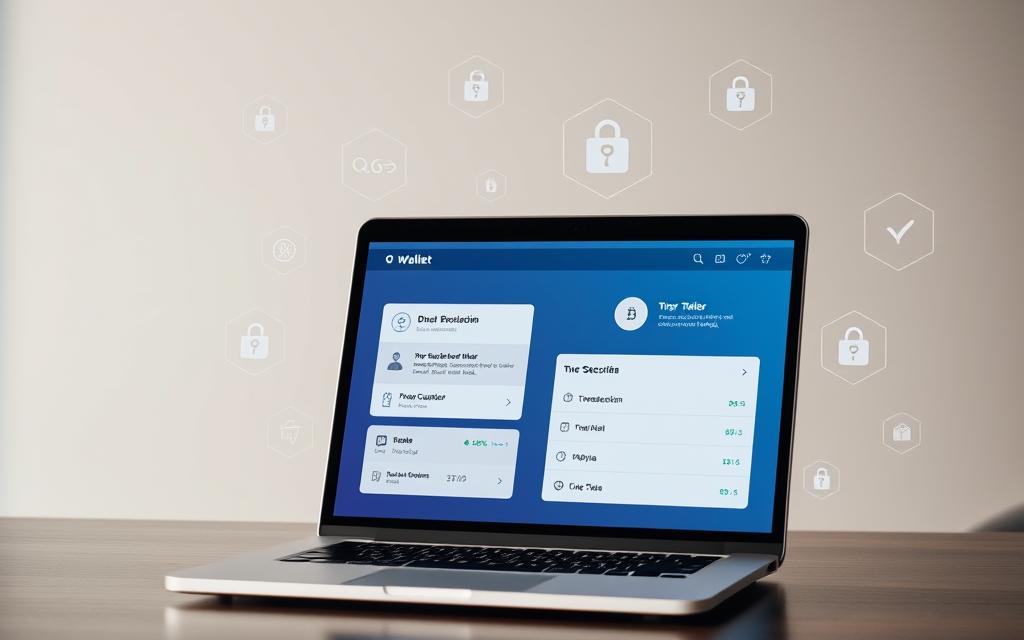Table of Contents
Blockchain adoption is growing rapidly, increasing demand for reliable storage solutions. Many users seek custom options, but security remains a top concern.
These tools don’t actually hold digital assets. Instead, they manage cryptographic keys that control access to blockchain records. The public key serves as an address, while the private key acts like a password.
Self-built solutions carry significant risks compared to audited platforms like MetaMask or Ledger. Without proper security protocols, vulnerabilities can lead to devastating losses.
Creating a robust system requires expertise in cryptography, API integration, and key management. Advanced projects typically take 9-12 months to complete, though white-label alternatives offer faster deployment in 3-6 weeks.
For those exploring options, established wallet solutions provide tested security features while custom development remains complex.
Understanding Cryptocurrency Wallets
Digital ownership requires secure access, making crypto wallets vital for blockchain interactions. These tools don’t store digital assets but manage the cryptographic keys controlling them. Think of it as a keychain for blockchain addresses rather than a physical vault.
What Is a Crypto Wallet?
A crypto wallet is a software interface for key pairs. The public key acts like a bank account number—shared to receive funds. The private key functions like a PIN, authorizing outgoing transactions.
How Crypto Wallets Work: Public and Private Keys
Modern wallets use standards like BIP-39 for 12 or 24-word seed phrases. These mnemonics generate hierarchical deterministic (HD) wallets under BIP-32, creating unlimited addresses from one root.
Ethereum employs the secp256k1 elliptic curve, similar to Bitcoin but with Keccak-256 hashing for address conversion. Bitcoin’s process differs slightly in encoding.
Private keys must remain confidential. Lose one, and access to linked digital assets vanishes. Public keys, however, are safe to share for receiving payments or verifying transactions.
Types of Cryptocurrency Wallets
Security preferences shape wallet choices, with different solutions excelling in specific use cases. From always-online interfaces to offline vaults, each type balances convenience and protection uniquely.

Hot Wallets vs. Cold Wallets
Hot wallets like MetaMask and Coinbase Wallet prioritize accessibility. These internet-connected tools enable instant transactions but face higher exposure to *browser vulnerabilities* or phishing attacks.
In contrast, cold wallets such as Ledger Nano X store keys offline. Physical devices like these resist remote hacking but require careful handling to prevent loss or theft.
“Cold storage offers bank-grade security for long-term holdings, while hot wallets serve as checking accounts for daily use.”
- Attack vectors differ: Hot wallets risk digital breaches; cold wallets face physical compromise.
- Paper wallets, once popular for cold storage, are now outdated due to fragility and usability issues.
Desktop, Mobile, and Web Wallets
Desktop wallets (e.g., Electrum) cater to advanced users with full-node synchronization and granular control. These locally installed apps avoid third-party risks but demand technical upkeep.
Mobile wallets dominate for everyday use, leveraging NFC payments and QR scanning. Their convenience comes with trade-offs—lost devices may grant access if unsecured.
Web wallets run in browsers, offering cross-device access. However, reliance on external servers for key management introduces trust dependencies.
| Type | Best For | Risk Factor |
|---|---|---|
| Hot Wallets | Frequent traders | Online threats |
| Hardware Wallets | Long-term storage | Physical damage |
| Mobile Wallets | Retail payments | Device theft |
Essential Tools and Technologies
Building secure digital asset management requires powerful software and precise integration of blockchain APIs. The right stack ensures smooth transactions, key security, and cross-platform compatibility.
Programming Languages and Frameworks
Node.js dominates backend development with libraries like ethers.js. For Ethereum Virtual Machine (EVM) chains, tools like web3.js and Hardhat simplify code testing.
Native mobile apps often use Java (Android) or Swift (iOS). These programming languages ensure performance but demand platform-specific adjustments.
Blockchain APIs and Libraries
Third-party blockchain APIs accelerate integration. Coinbase Exchange API and Infura’s RPC endpoints provide real-time data without running full nodes.
- BIP-39/44 standards enable cross-chain support via mnemonic phrases.
- AWS QLDB offers tamper-proof ledgers, while Azure Blockchain Workbench suits enterprise deployments.
| Tool | Use Case | Key Benefit |
|---|---|---|
| Node.js + ethers.js | Backend scripting | EVM compatibility |
| Infura API | Ethereum queries | No node maintenance |
| BIP-39 | Seed generation | Multi-chain recovery |
Selecting proven software minimizes risks. Always audit third-party code before deployment.
How to Develop a Cryptocurrency Wallet: Step-by-Step
The journey from concept to functional wallet involves multiple technical stages. Each phase requires specialized tools and security considerations to ensure reliable performance.

Setting Up Your Development Environment
Begin with Node.js and npm/yarn for package management. The ethereum-cryptography library provides essential functions for key generation and transaction signing.
Install testing frameworks like Hardhat for local blockchain simulations. This creates a safe environment for debugging before live deployment.
Generating Keys and Addresses
Use BIP-39 standards to create 256-bit entropy mnemonics. These 24-word phrases become the root for hierarchical deterministic wallets.
The HDKey.fromMasterSeed() method derives child keys while maintaining cryptographic relationships. For Ethereum, apply secp256k1 elliptic curve mathematics to generate public addresses.
“Proper key derivation separates amateur implementations from professional-grade solutions.”
Implementing Transaction Functionality
Integrate ethers.js Signer objects for Goerli testnet interactions. These handle nonce management and gas calculations automatically.
Test ETH transfers using these components:
- Local Hardhat node for instant feedback
- Balance checks before broadcasting
- Transaction receipt verification
| Development Phase | Critical Components | Testing Requirements |
|---|---|---|
| Environment Setup | Node.js, ethers.js | Package dependency checks |
| Key Generation | BIP-39, secp256k1 | Mnemonic recovery tests |
| Transactions | Signers, RPC providers | Testnet deployments |
This structured approach ensures robust wallet development while maintaining security throughout the process.
Security Best Practices for Wallet Development
Robust security measures separate trusted digital asset managers from vulnerable solutions. Every layer of protection must address both digital and physical threats while maintaining usability.

Implementing Multi-Layer Authentication
Two-factor authentication (2FA) should be mandatory for all access attempts. Combine SMS codes with authenticator apps like Google Authenticator for optimal protection.
Biometric verification adds another defense layer. Fingerprint or facial recognition prevents unauthorized mobile access even if devices are stolen.
For enterprise solutions, hardware security modules (HSMs) generate and store private keys in tamper-proof environments. These physical devices meet military-grade encryption standards.
Advanced Protection Protocols
Always encrypt sensitive data with AES-256 when at rest. TLS 1.3 secures all transmitted information, preventing man-in-the-middle attacks.
Regular security audits identify vulnerabilities before exploitation. Services like CertiK perform penetration testing and smart contract reviews quarterly.
Essential protection measures include:
- Hierarchical key storage with separate encryption for master keys
- Geographically distributed backup servers with air-gapped copies
- Real-time intrusion detection systems monitoring API traffic
| Security Feature | Implementation | Risk Mitigated |
|---|---|---|
| 2FA | Authy/TOTP integration | Credential stuffing |
| HSM | YubiKey/Fortanix | Physical key extraction |
| TLS 1.3 | Cloudflare/Let’s Encrypt | Network eavesdropping |
| AES-256 | OpenSSL libraries | Data breach impact |
These protocols create comprehensive defense systems. Balance stringent measures with user experience to ensure adoption.
Key Features to Include in Your Wallet
A well-designed crypto wallet app combines security with convenience. The right features enhance user experience while protecting digital assets. Below are essential components for modern solutions.
Multi-Currency Support and QR Code Scanning
Multi-currency compatibility is now standard. Using BIP-44 standards, wallets can manage BTC, ETH, and USDT in one interface. This eliminates the need for multiple apps.
Real-time price feeds via CoinGecko API keep users informed. Pair this with QR code scanning for instant transactions. The ZXing library offers reliable scanning for both Android and iOS platforms.
Push Notifications and Payment Gateways
Instant alerts for transactions improve security. Configure webhooks to notify users about deposits or withdrawals. This prevents unauthorized activity.
Integrating payment gateways like Stripe Crypto simplifies fiat conversions. Users can buy digital assets directly within the app. Session timeouts (15-minute inactivity) add an extra security layer.
| Feature | Implementation | User Benefit |
|---|---|---|
| Multi-Currency | BIP-44 hierarchy | Single-app convenience |
| QR Scanner | ZXing library | Faster transactions |
| Payment Gateways | Stripe integration | Fiat on-ramps |
| Notifications | Blockchain webhooks | Real-time alerts |
These features create a competitive crypto wallet app. Balance innovation with robust security for optimal results.
Testing and Debugging Your Wallet
Quality assurance separates trusted apps from risky prototypes. Comprehensive testing identifies vulnerabilities before real-world use. This phase ensures seamless crypto transactions and robust security.

Unit Testing and Security Audits
Write Mocha/Chai tests for key derivation paths. These scripts verify BIP-39 compliance and address generation accuracy. Chainlink’s example repositories offer reusable templates.
Simulate attacks with OWASP ZAP to detect MITM risks. For deeper analysis, hire ethical hackers via HackerOne. Their reports highlight flaws in:
- Gas fee calculations
- Cross-chain swap logic (e.g., THORChain)
- Session timeout enforcement
User Testing and Feedback
Recruit beta testers from Crypto Twitter communities. Early adopters stress-test features under real conditions. Monitor their pain points—like QR scan failures or delayed notifications.
“Beta phases reveal 80% of UX issues before launch.”
| Testing Method | Tool | Outcome |
|---|---|---|
| Unit Tests | Mocha/Chai | Code reliability |
| Penetration Tests | HackerOne | Security gaps |
| User Trials | Beta groups | UX improvements |
Iterate based on feedback to polish solutions. Fix critical bugs first, then optimize minor glitches. Post-launch, schedule quarterly audits to maintain trust.
Deployment and Maintenance
Launching a secure digital asset manager marks just the beginning. Ongoing vigilance ensures long-term reliability and protection against emerging threats. Proper deployment strategies and proactive maintenance separate professional solutions from temporary experiments.
Choosing a Hosting Solution
Enterprise-grade web applications demand robust infrastructure. AWS Managed Blockchain provides scalable node networks with automatic failover. Azure’s Kubernetes Service offers similar benefits for multi-cloud deployment.
Key considerations include:
- Geographic redundancy across availability zones
- DDoS protection with AWS Shield or Cloudflare
- Compliance certifications (SOC 2, ISO 27001)
White-label solutions like SDK.finance accelerate time-to-market. These pre-built platforms reduce initial setup costs while maintaining customization options.
Continuous Updates and Security Patches
Cyber threats evolve constantly, making regular updates non-negotiable. Automated CI/CD pipelines enable seamless security patches without service interruptions. Tools like GitHub Actions or GitLab CI streamline this process.
Essential maintenance practices:
- Real-time monitoring via Prometheus/Grafana dashboards
- Subscription to EthereumJS CVE alerts
- Quarterly hard fork preparedness checks
“Bug bounty programs with Immunefi uncover vulnerabilities before malicious actors exploit them.”
For comprehensive protection, consider partnering with a specialized development team. Their expertise ensures your web applications remain secure through every update cycle.
| Maintenance Task | Frequency | Tools |
|---|---|---|
| Dependency Updates | Weekly | Dependabot |
| Penetration Testing | Quarterly | HackerOne |
| Performance Audits | Bi-annually | Lighthouse |
Implementing these measures creates resilient systems. Stay ahead of threats while delivering uninterrupted service to users.
Conclusion
Businesses exploring digital asset management face complex technical challenges. Building hierarchical deterministic (HD wallets) requires deep blockchain expertise. Self-managed systems risk key loss or breaches without proper security protocols.
White-label solutions offer faster deployment for most business needs. Ongoing costs, like node maintenance (~$15k/month), make hybrid models ideal—custom interfaces with audited backends.
For reliable crypto wallet solutions, partner with professional teams. They ensure robust protection while saving development time and resources.
FAQ
What is the difference between hot and cold wallets?
Hot wallets stay connected to the internet, making transactions faster but less secure. Cold wallets store assets offline, offering stronger protection against hacks.
Which programming languages are best for wallet development?
JavaScript, Python, and Solidity are popular choices. Frameworks like React Native help build cross-platform mobile apps efficiently.
How do public and private keys work in crypto wallets?
Public keys act like bank account numbers for receiving funds. Private keys authorize transactions—losing them means losing access to assets.
What security features should a wallet have?
Two-factor authentication (2FA), biometric login, and hardware encryption are critical. Regular audits prevent vulnerabilities.
Can wallets support multiple cryptocurrencies?
Yes. Integrating APIs like Coinbase or Binance allows handling Bitcoin, Ethereum, and other digital assets in one app.
Why is backup important for wallet security?
Backups restore access if devices fail. Use encrypted cloud storage or hardware devices like Ledger for recovery phrases.
How long does it take to build a wallet?
A basic version takes 3-6 months. Complex features like smart contracts or DeFi integration extend timelines.
What’s the cost of developing a wallet?
Costs range from ,000 for a simple app to 0,000+ for advanced solutions with custom blockchain integration.









